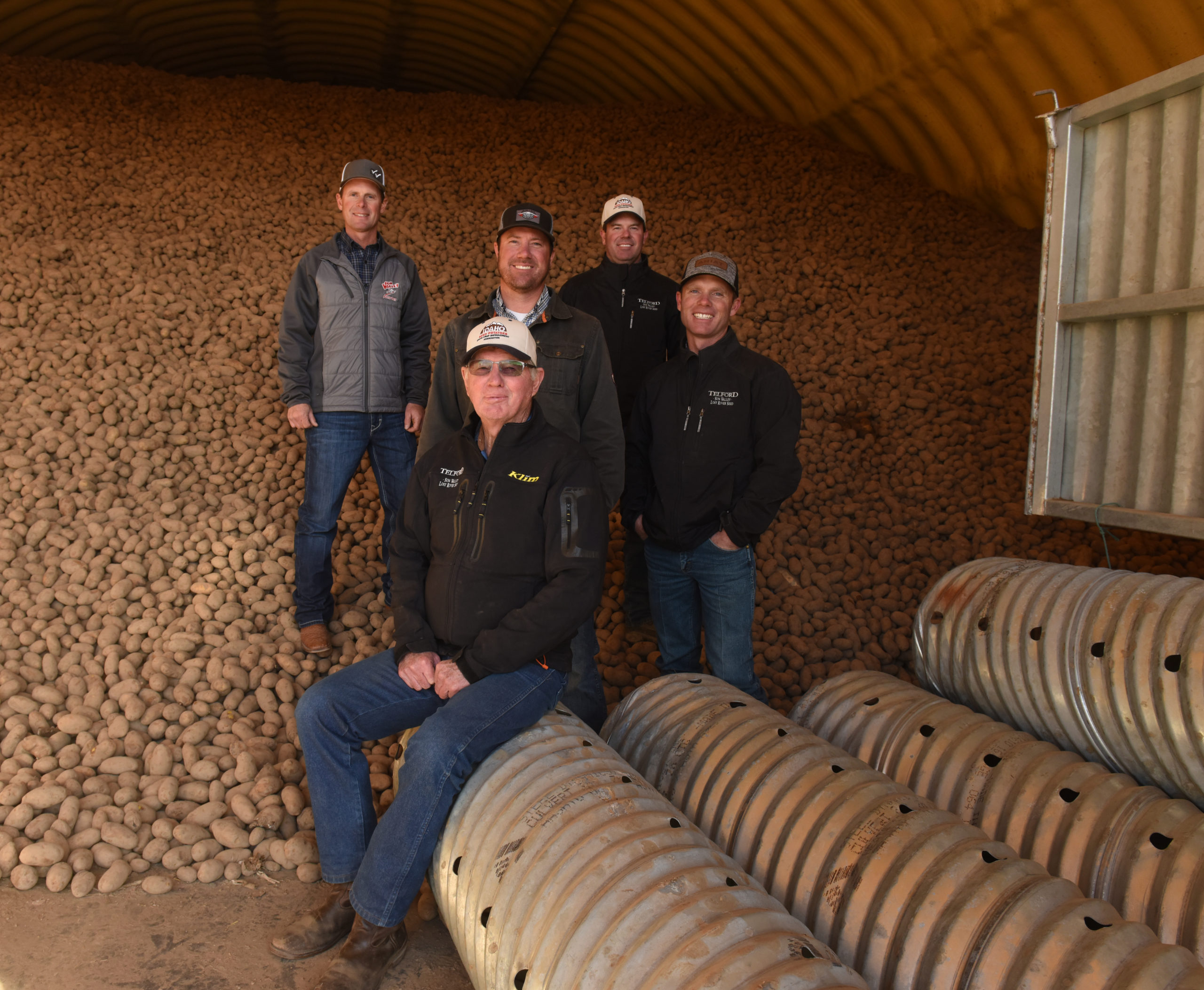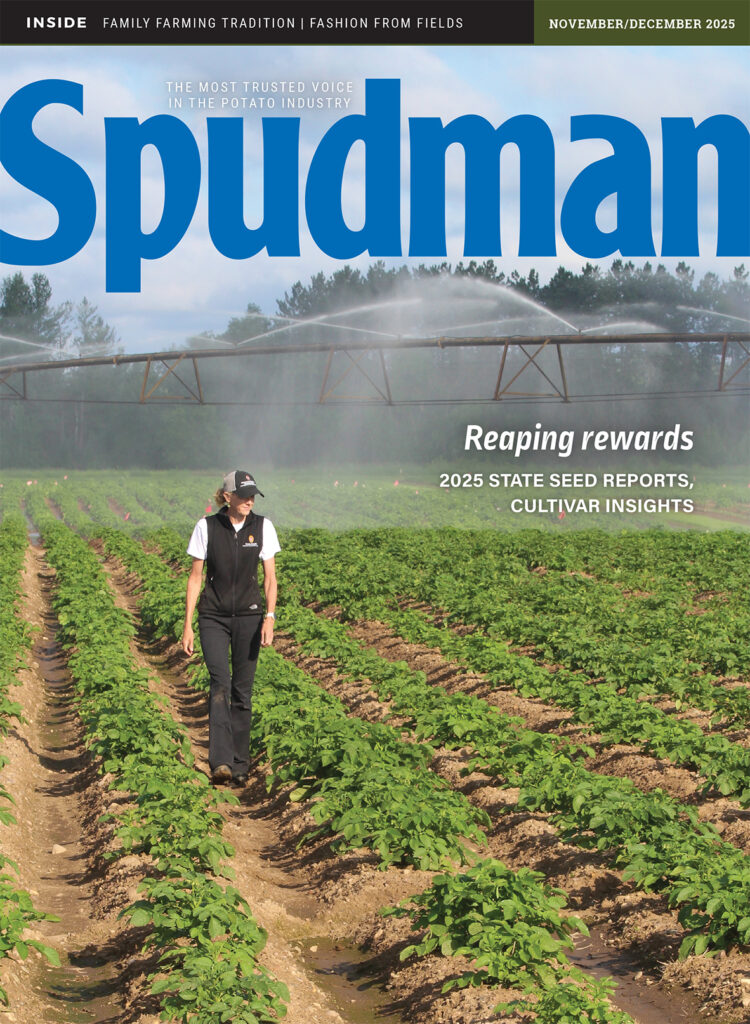Storing Potatoes
Proper storage techniques can reduce disease pressure
Storage conditions can be ripe for diseases to develop and devastate potato crops, leading many universities to seek ways to control or prevent diseases before they become a problem. At the University of Maine (UM) a fungicide testing program looks at new chemicals and their potential for preventing potato diseases, as well as new uses for current chemicals.
“There are no postharvest diseases, so the problem begins in the field or delivery into storage,” said Steve Johnson, a potato specialist with the UM Cooperative Extension, Presque Isle.
“As you store potatoes longer, it certainly does get to be a problem. Whether it’s fresh cut or processed, any amount (of disease) you can lower is a good thing,” Johnson said.
Multiple diseases such as late blight, pink rot, leak, black dot and silver scurf impact Maine’s potato fields. Johnson is the leader of the UM testing program, looking at the effectiveness of new products and new uses for current chemicals. Two are scheduled for fall testing, but Johnson was hesitant to name them because they currently aren’t labeled for potatoes. Those potential potato fungicides may soon receive labeling if they show success in battling disease.
Agraquest’s Serenade and Syngenta’s Mertect are two fungicides labeled for potatoes Johnson has studied, each showing positive reductions in silver scurf, but so far, Johnson has yet to see similar effects on black dot.
Even with the success of many fungicides, Johnson is seeking alternatives that can provide adequate disease reduction while limiting environmental impacts. Phosphorous acid is one such alternative that is already seeing use in Maine. Through phosphorous acid field trials, Johnson has seen reductions in late blight, pink rot and leak. Compounds with similar structures to bleach have shown mixed results.
Johnson hasn’t seen complete protection from traditional fungicides or alternatives, and one of the best defenses is controlling how long tubers are left in the field after vine killing, which Johnson recommends at 14 to 21 days. Whether potatoes are left in the ground too long or harvested too early, they remain susceptible to disease outside that three-week period.
“There really isn’t anything that’s a silver bullet, but I expect in the next few years to have some options for the materials. A lot of it is good seed and seed treatments, and good disease control during the growing season,” he said.
Fusarium dry rot has been a battle for more than 10 years for Barry Jacobsen, a Montana State University professor of plant pathology specializing in potatoes and sugar beets. The disease thrives with temperatures higher than 60° F, and harvest conditions can be easily favorable for disease growth. All it takes is injuries and bruises, so Jacobsen has been studying biological and chemical controls for storage.
Success has come through a biological product known as BioSave, a bacterial-based fungicide that protects against fungal and bacterial pathogens by colonizing injuries and cracks in the skin, preventing them from gaining a foothold on the potatoes. It can be applied in standard spray applications as potatoes exit bulk bins or over conveyor belts prior to piling.
“You have to remember, it’s a living organism, so once it’s mixed with water in the mix tank, it’s only good for 24 hours,” Jacobsen said.
BioSave has reduced disease by as much as 80 percent, and when combined with traditional fungicides, that percentage increases, he said.
Traditional fungicides have also received scrutiny at MSU, specifically azoxystrobin and difenocazole, two fungicides marketed by Syngenta as Quadris and Inspire, respectively. Azoxystorbin has been particularly effective on silver scurf, while difenocazole works well on fusarium dry rot. Neither one is labeled for potatoes, but Jacobsen has seen enough success that he hopes they may soon receive those designations, he said.
More than half the isolates for fusarium dry rot in Montana are resistant to Mertect, which presents a serious problem for Montana growers, as they are a leading potato seed state. Growers are finding a solution to the problem through fungicide combinations, which lower the risk of resistance to either fungicide.
“Resistance is likely to occur with azoxystrobin and difenocazole if used alone, but when combined with two modes of action, that risk of immunity is much less. If we get resistance, all our customers get resistance, so we’re looking closely at using combinations of treatments,” Jacobsen said.
BioSave has provided adequate protection against resistance when combined with traditional fungicides. Fungal resistance is dramatically reduced, while efficacy of both chemicals increases. But one of the best protections may not be in fungicides, but through crop control to allow the potatoes enough time to heal to prevent fusarium dry rot infestations.
“There’s not much growers can do to avoid fusarium dry rot or silver scurf diseases since these fungi are common in most potato soils. Control is dependent on controlling the crop after harvest to allow injuries to heal and use post harvest biological or fungicide control,” Jacobsen said. “We have some new tools producers can use for good control over fungus; it’s when conditions aren’t perfect that it’s harder.”














